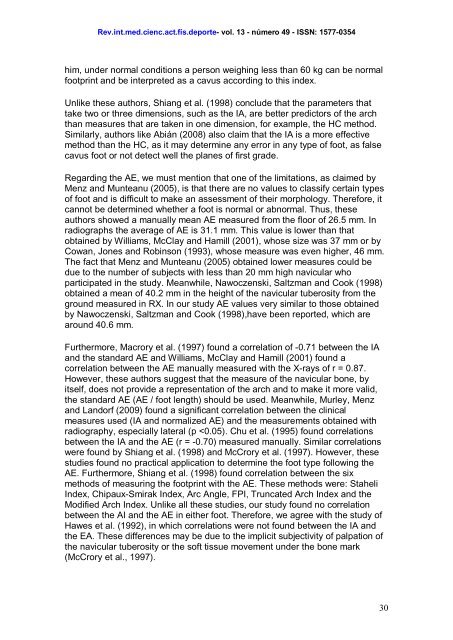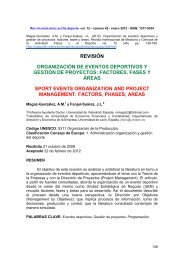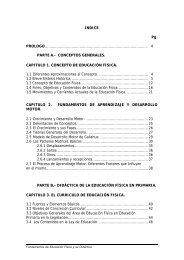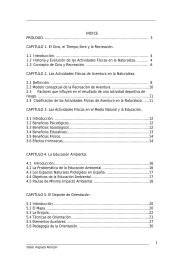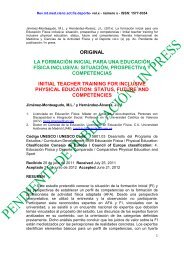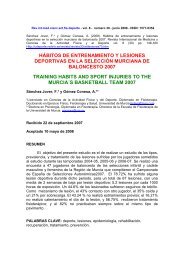English - Comunidad Virtual CIENCIAS DEL DEPORTE - RedIRIS
English - Comunidad Virtual CIENCIAS DEL DEPORTE - RedIRIS
English - Comunidad Virtual CIENCIAS DEL DEPORTE - RedIRIS
Create successful ePaper yourself
Turn your PDF publications into a flip-book with our unique Google optimized e-Paper software.
Rev.int.med.cienc.act.fís.deporte- vol. 13 - número 49 - ISSN: 1577-0354<br />
him, under normal conditions a person weighing less than 60 kg can be normal<br />
footprint and be interpreted as a cavus according to this index.<br />
Unlike these authors, Shiang et al. (1998) conclude that the parameters that<br />
take two or three dimensions, such as the IA, are better predictors of the arch<br />
than measures that are taken in one dimension, for example, the HC method.<br />
Similarly, authors like Abián (2008) also claim that the IA is a more effective<br />
method than the HC, as it may determine any error in any type of foot, as false<br />
cavus foot or not detect well the planes of first grade.<br />
Regarding the AE, we must mention that one of the limitations, as claimed by<br />
Menz and Munteanu (2005), is that there are no values to classify certain types<br />
of foot and is difficult to make an assessment of their morphology. Therefore, it<br />
cannot be determined whether a foot is normal or abnormal. Thus, these<br />
authors showed a manually mean AE measured from the floor of 26.5 mm. In<br />
radiographs the average of AE is 31.1 mm. This value is lower than that<br />
obtained by Williams, McClay and Hamill (2001), whose size was 37 mm or by<br />
Cowan, Jones and Robinson (1993), whose measure was even higher, 46 mm.<br />
The fact that Menz and Munteanu (2005) obtained lower measures could be<br />
due to the number of subjects with less than 20 mm high navicular who<br />
participated in the study. Meanwhile, Nawoczenski, Saltzman and Cook (1998)<br />
obtained a mean of 40.2 mm in the height of the navicular tuberosity from the<br />
ground measured in RX. In our study AE values very similar to those obtained<br />
by Nawoczenski, Saltzman and Cook (1998),have been reported, which are<br />
around 40.6 mm.<br />
Furthermore, Macrory et al. (1997) found a correlation of -0.71 between the IA<br />
and the standard AE and Williams, McClay and Hamill (2001) found a<br />
correlation between the AE manually measured with the X-rays of r = 0.87.<br />
However, these authors suggest that the measure of the navicular bone, by<br />
itself, does not provide a representation of the arch and to make it more valid,<br />
the standard AE (AE / foot length) should be used. Meanwhile, Murley, Menz<br />
and Landorf (2009) found a significant correlation between the clinical<br />
measures used (IA and normalized AE) and the measurements obtained with<br />
radiography, especially lateral (p


